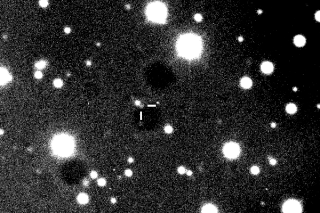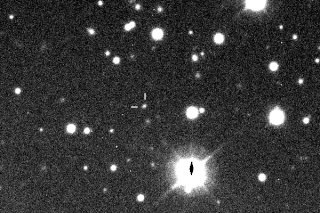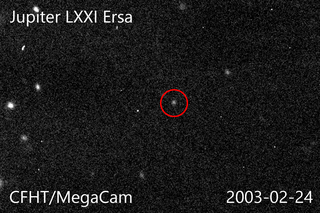Related Research Articles

Carme is a retrograde irregular satellite of Jupiter. It was discovered by Seth Barnes Nicholson at Mount Wilson Observatory in California in July 1938. It is named after the mythological Carme, mother by Zeus of Britomartis, a Cretan goddess.

There are 95 moons of Jupiter with confirmed orbits as of 5 February 2024. This number does not include a number of meter-sized moonlets thought to be shed from the inner moons, nor hundreds of possible kilometer-sized outer irregular moons that were only briefly captured by telescopes. All together, Jupiter's moons form a satellite system called the Jovian system. The most massive of the moons are the four Galilean moons: Io, Europa, Ganymede, and Callisto, which were independently discovered in 1610 by Galileo Galilei and Simon Marius and were the first objects found to orbit a body that was neither Earth nor the Sun. Much more recently, beginning in 1892, dozens of far smaller Jovian moons have been detected and have received the names of lovers or daughters of the Roman god Jupiter or his Greek equivalent Zeus. The Galilean moons are by far the largest and most massive objects to orbit Jupiter, with the remaining 91 known moons and the rings together comprising just 0.003% of the total orbiting mass.

Chaldene, also known as Jupiter XXI, is a retrograde irregular satellite of Jupiter. It was discovered by a team of astronomers from the University of Hawaii led by Scott S. Sheppard, in 2000, and given the temporary designation S/2000 J 10.

Isonoe, also known as Jupiter XXVI, is a retrograde irregular satellite of Jupiter. It was discovered by a team of astronomers from the University of Hawaii led by Scott S. Sheppard in 2000, and given the temporary designation S/2000 J 6.

Taygete, also known as Jupiter XX, is a retrograde irregular satellite of Jupiter. It was discovered by a team of astronomers from the University of Hawaii led by Scott S. Sheppard, in 2000, and given the temporary designation S/2000 J 9.

Kalyke, also known as Jupiter XXIII, is a retrograde irregular satellite of Jupiter. It was discovered by a team of astronomers from the University of Hawaii led by Scott S. Sheppard in 2000, and given the temporary designation S/2000 J 2.

S/2003 J 9 is a retrograde irregular satellite of Jupiter. It was discovered by a team of astronomers from the University of Hawaii led by Scott S. Sheppard in 2003.

Carpo, also Jupiter XLVI, is a small outer natural satellite of Jupiter. It was discovered by a team of astronomers from the University of Hawaii led by Scott S. Sheppard in 2003, and was provisionally designated as S/2003 J 20 until it received its name in early 2005. It was named in March 2005 after Carpo, one of the Horae, and a daughter of Zeus (Jupiter).

Valetudo, also known as Jupiter LXII and originally known as S/2016 J 2, is an irregular moon of Jupiter. It was discovered by Scott S. Sheppard and his team in data acquired by the 6.5-m Magellan-Baade telescope of the Las Campanas Observatory in 2016, but was not announced until 17 July 2018, via a Minor Planet Electronic Circular from the Minor Planet Center, which also reported the discovery of nine other of Jupiter's moons. Besides data from Las Campanas, the original announcement also referred to data acquired through the 8.1-m Gemini North telescope of the Mauna Kea Observatories as well as the 4.0-m reflector of the Cerro Tololo Inter-American Observatory.

Ersa, also designated Jupiter LXXI, is a small outer natural satellite of Jupiter discovered by Scott S. Sheppard on 11 May 2018, using the 4.0-meter Víctor M. Blanco Telescope at Cerro Tololo Observatory, Chile. It was announced alongside nine other Jovian moons on 17 July 2018 and was provisionally designated S/2018 J 1 by the Minor Planet Center, after observations were collected over a long enough time span to confirm the satellite's orbit. The satellite has been found in precovery observations as early as 6 August 2000.

Pandia, also designated Jupiter LXV, is a small outer natural satellite of Jupiter discovered by Scott S. Sheppard on 11 May 2018, using the 4.0-meter Víctor M. Blanco Telescope at Cerro Tololo Observatory, Chile. It was announced alongside nine other Jovian moons on 17 July 2018 and it provisionally designated S/2017 J 4 by the Minor Planet Center, after observations were collected over a long enough time span to confirm the satellite's orbit. The satellite has been found in precovery observations as early as 2003.
S/2016 J 3 is a small outer natural satellite of Jupiter discovered by Scott S. Sheppard on 9 March 2016, using the 6.5-meter Magellan-Baade Telescope at Las Campanas Observatory, Chile. It was announced by the Minor Planet Center 7 years later on 5 January 2023, after observations were collected over a long enough time span to confirm the satellite's orbit.
S/2021 J 1 is a small outer natural satellite of Jupiter discovered by Scott S. Sheppard on 12 August 2021, using the 6.5-meter Magellan-Baade Telescope at Las Campanas Observatory, Chile. It was announced by the Minor Planet Center on 5 January 2023, after observations were collected over a long enough time span to confirm the satellite's orbit.
S/2018 J 4 is a small outer natural satellite of Jupiter discovered by Scott S. Sheppard on 11 May 2018, using the 4.0-meter Víctor M. Blanco Telescope at Cerro Tololo Observatory, Chile. It was announced by the Minor Planet Center on 20 January 2023, after observations were collected over a long enough time span to confirm the satellite's orbit. The satellite has a diameter of about 2 km (1.2 mi) for an absolute magnitude of 16.7.
S/2021 J 2 is a small outer natural satellite of Jupiter discovered by Scott S. Sheppard on 12 August 2021, using the 6.5-meter Magellan-Baade Telescope at Las Campanas Observatory, Chile. It was announced by the Minor Planet Center on 19 January 2023, after observations were collected over a long enough time span to confirm the satellite's orbit.
S/2021 J 4 is a small outer natural satellite of Jupiter discovered by Scott S. Sheppard on 14 August 2021, using the 6.5-meter Magellan-Baade Telescope at Las Campanas Observatory, Chile. It was announced by the Minor Planet Center on 19 January 2023, after observations were collected over a long enough time span to confirm the satellite's orbit.
S/2021 J 5 is a small outer natural satellite of Jupiter discovered by Scott S. Sheppard, David J. Tholen, and Chad Trujillo on 5 September 2021, using the 8.2-meter Subaru Telescope at Mauna Kea Observatory, Hawaii. It was announced by the Minor Planet Center on 19 January 2023, after observations were collected over a long enough time span to confirm the satellite's orbit.
S/2021 J 6 is a small outer natural satellite of Jupiter discovered by Scott S. Sheppard, David J. Tholen, and Chad Trujillo on 5 September 2021, using the 8.2-meter Subaru Telescope at Mauna Kea Observatory, Hawaii. It was announced by the Minor Planet Center on 20 January 2023, after observations were collected over a long enough time span to confirm the satellite's orbit. The satellite has been found in precovery observations as early as 2 October 2010.
S/2022 J 1 is a small outer natural satellite of Jupiter discovered by Scott S. Sheppard on 30 August 2022, using the 4.0-meter Víctor M. Blanco Telescope at Cerro Tololo Observatory, Chile. It was announced by the Minor Planet Center on 22 February 2023, after observations were collected over a long enough time span to confirm the satellite's orbit.
S/2022 J 2 is a small outer natural satellite of Jupiter discovered by Scott S. Sheppard on 15 October 2022 using the 6.5-meter Magellan-Baade Telescope at Las Campanas Observatory, Chile. It was announced by the Minor Planet Center on 22 February 2023, after observations were collected over a long enough time span to confirm the satellite's orbit.
References
- 1 2 3 4 "MPEC 2023-B38 : S/2018 J 3". Minor Planet Electronic Circulars. Minor Planet Center. 19 January 2023. Retrieved 20 January 2023.
- ↑ "Planetary Satellite Discovery Circumstances". JPL Solar System Dynamics. NASA. Retrieved 10 January 2023.
- 1 2 3 4 Sheppard, Scott S. "Moons of Jupiter". Earth & Planets Laboratory. Carnegie Institution for Science. Retrieved 10 January 2023.